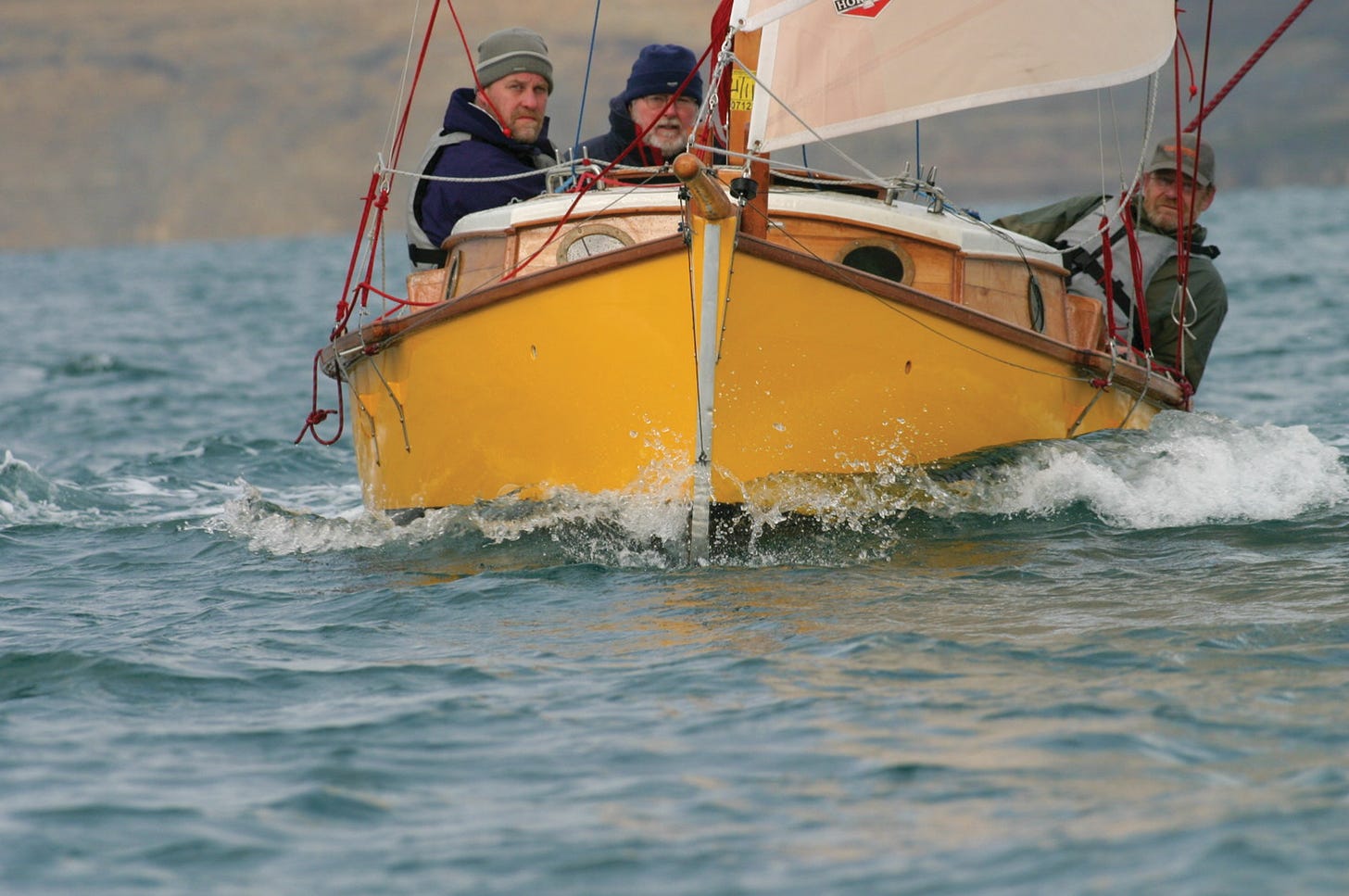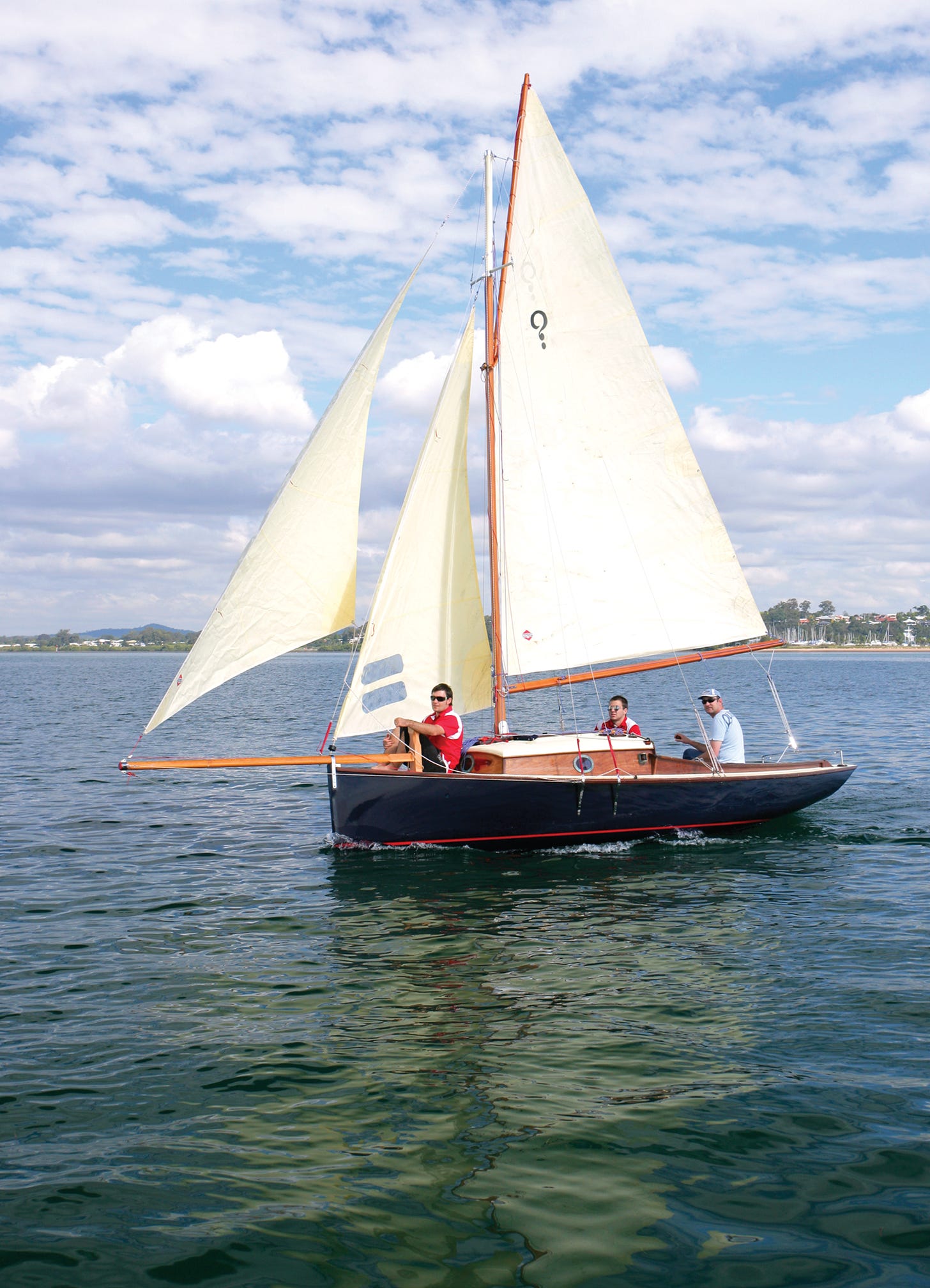by Derek Ellard
The Secret 20 was inspired by a friend’s father’s yacht Secret built on the East Coast of England where I grew up and learned the ways of the sea. The original Secret was built in 1932 as a smack yacht—a traditional Essex gaff-rigged trawler in every respect except that spartan accommodation was provided.
She was and remains “one of the prettiest little smacks ever built” and is undeniably fast and wonderfully sea kindly. By the nineteen sixties old man Hughes had sold the Secret but was still upset about losing her. His son and I hatched a plan to build a replacement—smaller, lighter but with plenty of Essex DNA. It never happened of course—this was the sixties after all and south east England, along with San Francisco, was the centre of the alternative universe.
Fast forward nearly forty years and 12,000 miles and the first Secret 20 hit the Australian waters flying. The rig is pure 19th century but with hollow spars, modern custom chandlery and sails made by one of Australia’s top young racing sailmakers. She flies. The hull form is pure Edwardian above the waterline but below she’s akin to the fifties racing dinghies that scared me as a lad. With high-strength, low-weight cedar/ply composite construction and modest ballast, she is beautifully balanced and will hit 6-plus knots in anything over 9 knots of wind.
SECRET 20
LOA: 27'
LOD: 20'
Weight: 1430 lb
Beam: 7'
Draft: 2' 3"
Sail Area: 259 sq ft
The perennial Scruffie Marine design brief was, and is, simple: design and build the very best boat of her type. Easy to say but a mountain to conquer—it took a year of my life to develop the Secret. The hull form is semi-displacement with fairly flat sections and a firm yet nicely rounded turn to the bilges. Her stem is nearly plumb with a barely perceptible curve. The waterline stretches out to a gently sweeping counter stern. When pushed to hull speed the wake builds right up to her rear deck, increasing the waterline and thus the speed. With a generous beam well aft, form stability is good yet a fine entry maintains good wake displacement. Careful attention to her three-quarter length ballasted fixed keel and rudder minimize drag, generate “lift” and maximize lateral resistance.
Construction is of an interlocking framework of marine ply with multiple stringers and strip planked bilges. The flatter hull sections are clad in marine ply and the whole is glassed and faired.
With an all up weight of 600 to 650 kg (around 1400 pounds, depending on fit-out and trimming ballast), she is amazingly light for a ballasted keel boat, yet on the water she is stable and stands up to her canvas well. I rigged her as per the 1932 Secret, a gaff cutter which, for the uninitiated is a gaff mainsail with a roller furling foresail (or staysail) immediately in front of the main and a jib set “flying” on the end of a bowsprit. A selection of these jibs including a huge reaching gennaker and a smaller heavy weather sail allows for infinite wind strengths while the main has two deep reef points. I peaked the mainsail gaff fairly high to enhance windward work and yet retain the low aspect power of the sail. A gentle roach with generous battens and a decent shape were the finishing touches. No topsails were envisaged, but our new 28-footer will carry a jackyard topsail—so called because the two “yards” on mast and gaff increase the sail way beyond the spar extremities. The jackyard is the one on the gaff; this sail is for serious sailors only and comes with a health warning. So it had to be a gaff cutter, the rig voted “most likely to engender unreasonable lust.” Complicated? Yes, a bit. Quick to rig? Not really but who cares? Lovely to behold? Oh yes! A delight to sail? Absolutely! Of course none of this matters unless the boat delivers big time and I believe this little boat does that—100%.
So, best of her type? Well let me put it this way. I hereby challenge anyone out there to put a 20-foot traditionally rigged trailersailer on the water with a well built competently sailed Secret 20 and outsail her on all points—especially to windward. The challenger must be comprehensively superior in every single aspect of performance in conditions from Force 1 to Force 5 (2 to 3 knots to 30 plus knots.) The challenger must be better balanced, nimbler, faster and more seakindly yet still offer comparable accommodation in cabin and cockpit and be able to be towed by a modest family car. Lastly she must be within the means of a decent handyman to build and sail and be favourably judged on aesthetic appeal too. Any challenger duly judged the winner by a panel of impartial experts on small craft will be rewarded by the publication of a groveling, resentful, sulky admission of defeat by myself in these pages.
Clearly I’m inordinately proud of her, she has forged an excellent reputation in the UK and Australia. So I have great expectations for the new Secret 28—a logical evolution of our very successful 20—still trailerable but much quicker, and I can’t wait to set that jackyard topsail!
I’m hopelessly biased but the reviewers will have the final say. We’re building the new boat from foam core and glass with interchangeable keels for power or sail—a skeg for the solar electric launches and a proper ballasted keel for the sailing version. They will be shipped worldwide as finished boats and kits, this time with GRP hull/deck/keel mouldings bonded together ready to fit out and rig.
Lastly, we’ve begun discussions with potential West Coast representatives to make it easier for North American customers to strut their stuff in fast funky gaffers. •SCA•
Contact: www.scruffie.com
First published in issue #61





I built and sailed a Secret 20 a decade or more ago. She’s a lovely boat but I soon found that she’s not a great choice for someone who mostly sails solo (surprise, surprise, my fault not the boats!). I found the biggest challenge was finding somewhere to launch a fixed keel boat and setting her up to go sailing is quite a task for one. As to Derek’s challenge I’m sure the Secret 20 holds her own against many a contender, John Welsford’s Penguin might do well.